Highlights of the Amsterdam Pipe Museum
Author:
Don Duco
Original Title:
Hoogtepunten uit het Amsterdam Pipe Museum
Publication Year:
2020
Publisher:
Amsterdam Pipe Museum (Stichting Pijpenkabinet)
Mythological animal
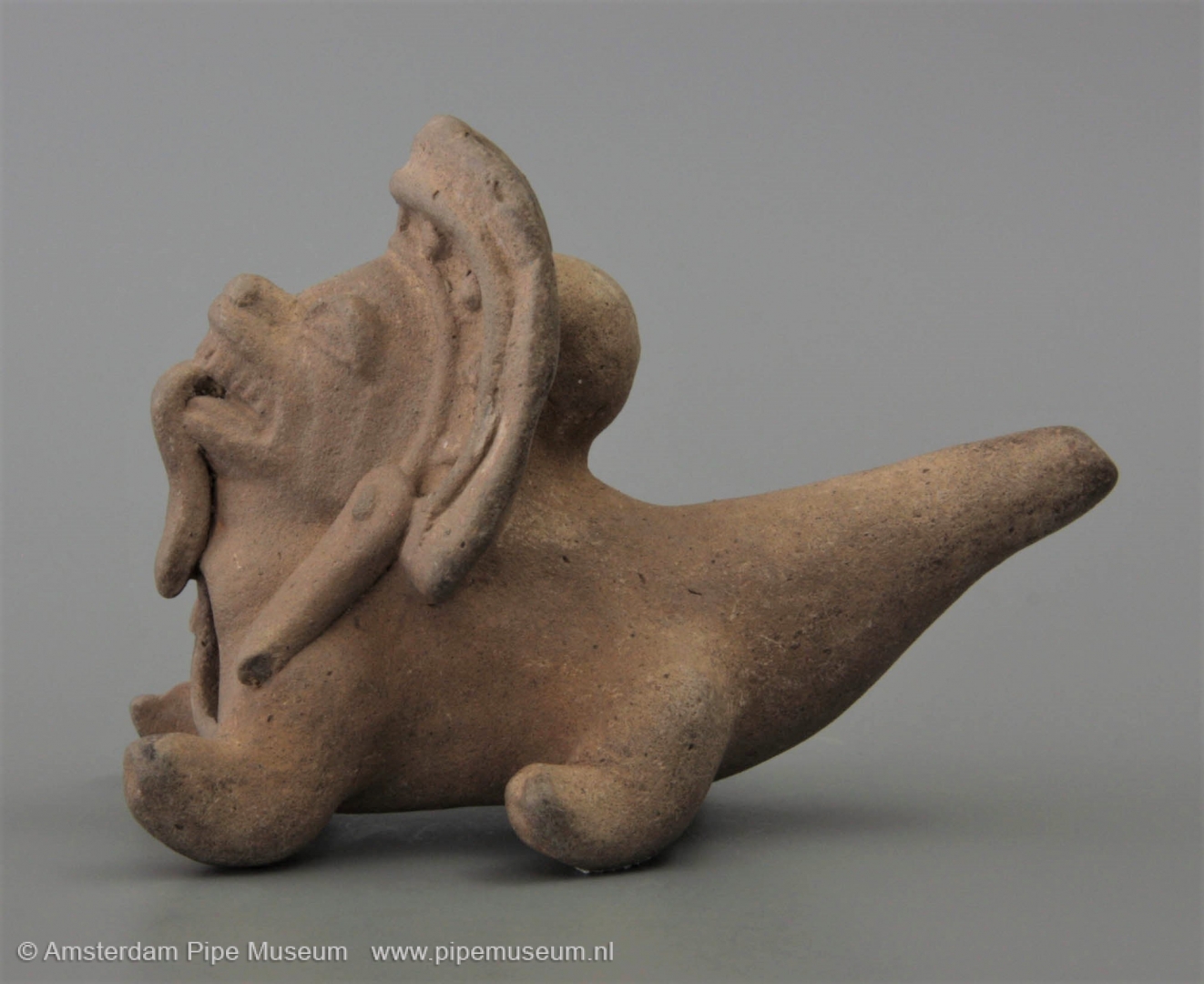
The primal shape of the tobacco pipe does not show the pipe bowl as we known it with a hollow stem attached in an angle, but has a tubular shape. This so-called tubular extends from the narrow mouthpiece to the opposite end in a kind of wider opening or pipe bowl. Here the tobacco can be packed. The tubular remains a simple but popular shape for the smoking pipe for centuries.
Several such tubular pipes are known from Ecuador, which are occasionally figural in a beautiful and original way. This happened mainly at the Jama-Coaque culture in the Manabi region. This tribe did not have the wish to make a comfortable stemmed pipe with an upright pipe bowl. They were used to the tubular shape, in line with the customs and rite of smoking. However, there was great interest in decorating the tubular pipe by figuring it out. In its most elaborate form the artistic decoration completely overshadows the pipe shape.
The illustrated pipe is such a marvelous example. The simple tubular shape is completely hidden in a lying mythological animal, the representation of a wolf or lion. The technique of manufacturing is remarkable. The basic shape of the pipe is made by hand, the tail of the animal being the mouthpiece of the pipe. The legs on both sides of the stem are hand-sculpted. Subsequently, a mask-like head applied to the upper side, was produced with a simple printing mould. Finally, details such as earrings and a tongue were hand formed and added by hand.
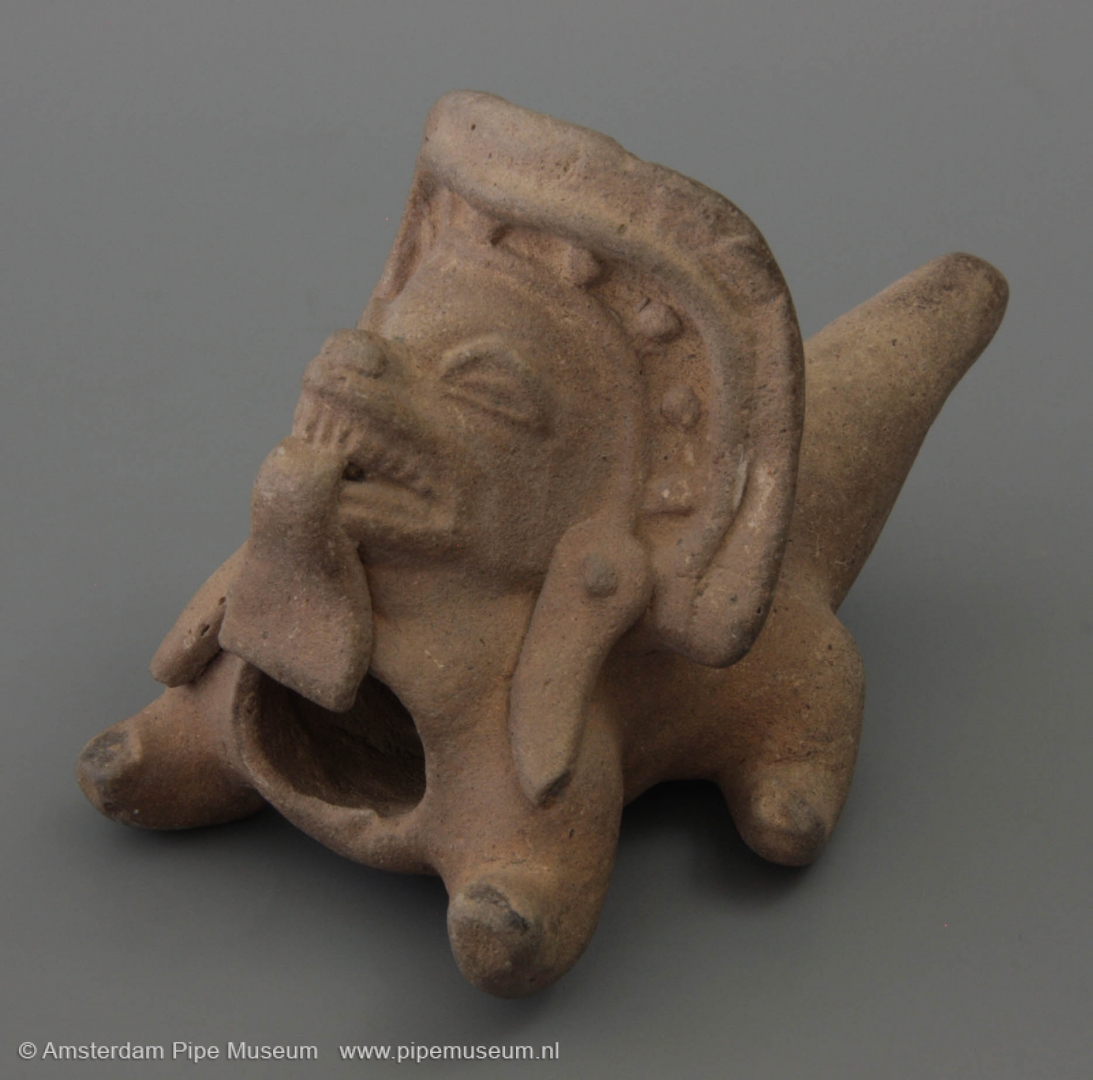
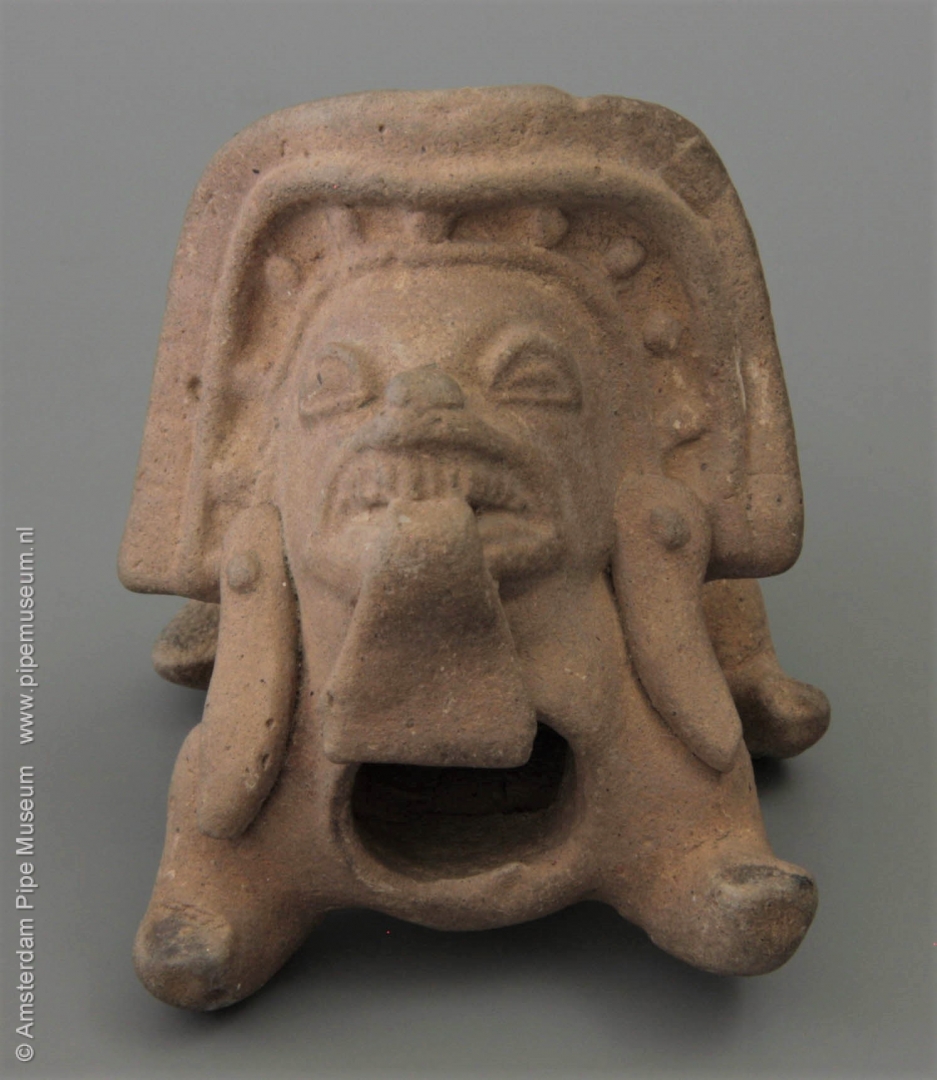
The representation is really artistic, the animal is in a defensive position, the head surrounded by a broad geometric headdress. A triangular flared tongue and comma-shaped earrings complete the image. Characteristic of the tubular pipe is of course the fact that the bowl is located at the front and is not positioned at an angle of ninety degrees to the stem. In the latter case, it would end up behind the head of the animal, as is usual with the standard pipe. After the product was baked, some details were probably polychromed, so that a colourful result was obtained. These colours have disappeared in the course of more than two millennia.
Such objects from the Jama-Coaque culture date from 550 BC. This specimen will date from the fifth or fourth century BC. These are rare archaeological examples from the prehistory of smoking that prove with their artistic element that tobacco use evoked inspiration already in the earliest phase.
Amsterdam Pipe Museum APM 13.513
The mescaline cactus as inspiration
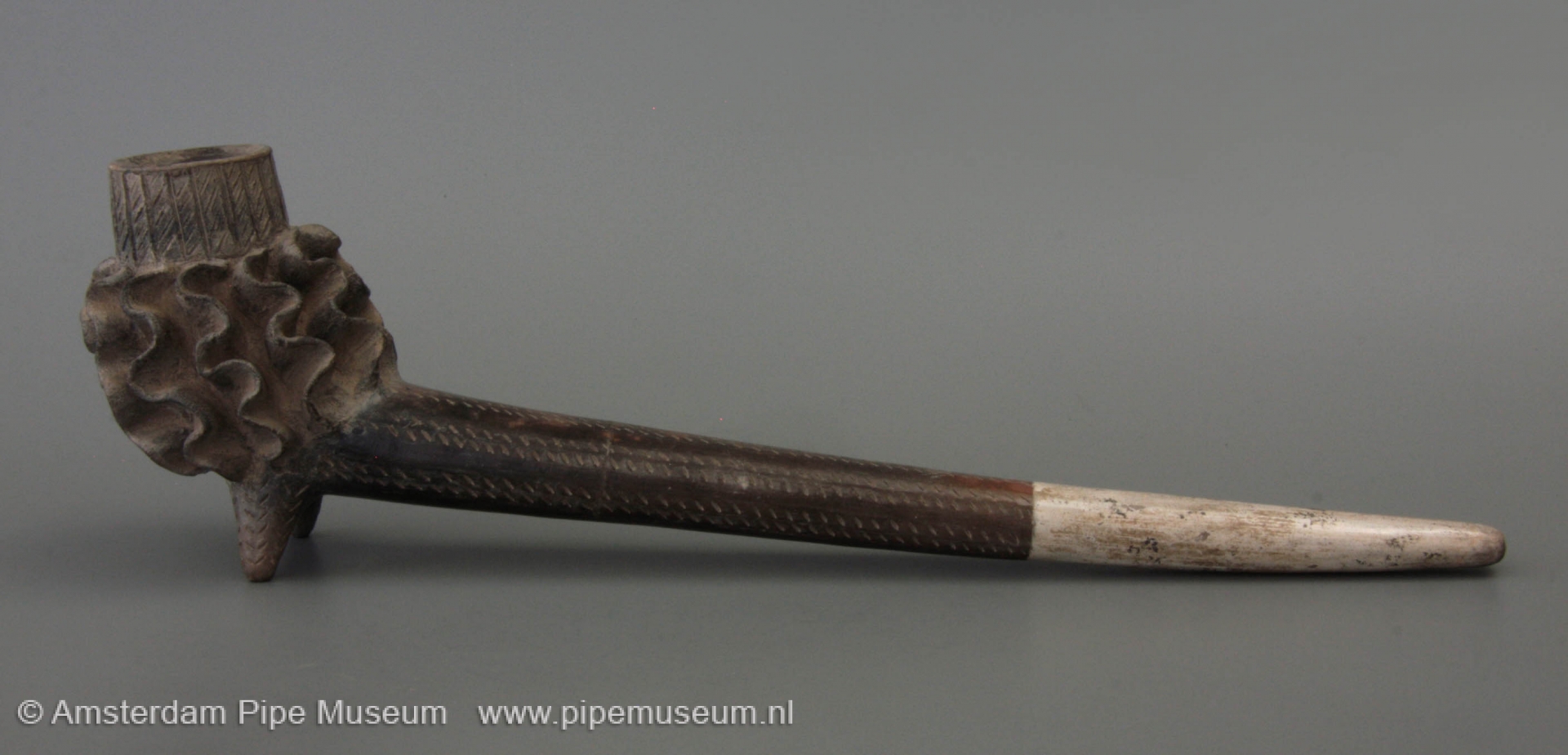
The most characteristic pre-Columbian pipe has a bowl shape that is inspired by nature. For the pipe bowl the mescaline cactus was copied, a spherical cactus with vertical cooling fins. The mescaline cactus is a common plant in those areas, often with an aerial root that is depicted in the pipe stem. When the cactus blooms, one large flower appears in the crown, initially as a cylindrical bud but spreading out to a calyx in full bloom. In the smoking pipes according to the example of this cactus, the different stages of flowering are shown, with full bloom being the most common. Rare is the representation of a cactus without a flower. The pipe shown is particularly special because the flower is still shown in the bud, which rises from the cactus like a cylindrical box.
In the stem of the pipe, the maker depicted an aerial root and thus gave an extra realistic dimension to his creation. Referring to the root structure, the stems are often provided with a repetitive pattern of imprinted stripes. The two legs at the bottom of the bowl on which the pipe can stand is a Mexican tradition. Cactus pipes are finished in different ways. Sometimes the pipe has the colour of the ceramic itself from greyish to terracotta red but usually it gets slip colour accents. With this pipe, the greyish colour of the ceramic stands out, expecially with the striking effect through partial polishing. The mouthpiece is appropriately accentuated with white slib, which is also polished.
The mescaline cactus itself was used as a stimulant by the Indian tribes. At religious festivals people ate dried pieces, called peyotl or pellote. They provided hour-long wooziness and associated colour visions. Reason to portray this cactus in a pipe is certainly not in the need to recast nature in utensils, that doesn’t fit this culture. Rather, a relation has been established between the hallucinogenic effect of the cactus and the mind-blowing effect of the nicotine in the tobacco. The extent to which the dried pieces of cactus were smoked as well is not certain.
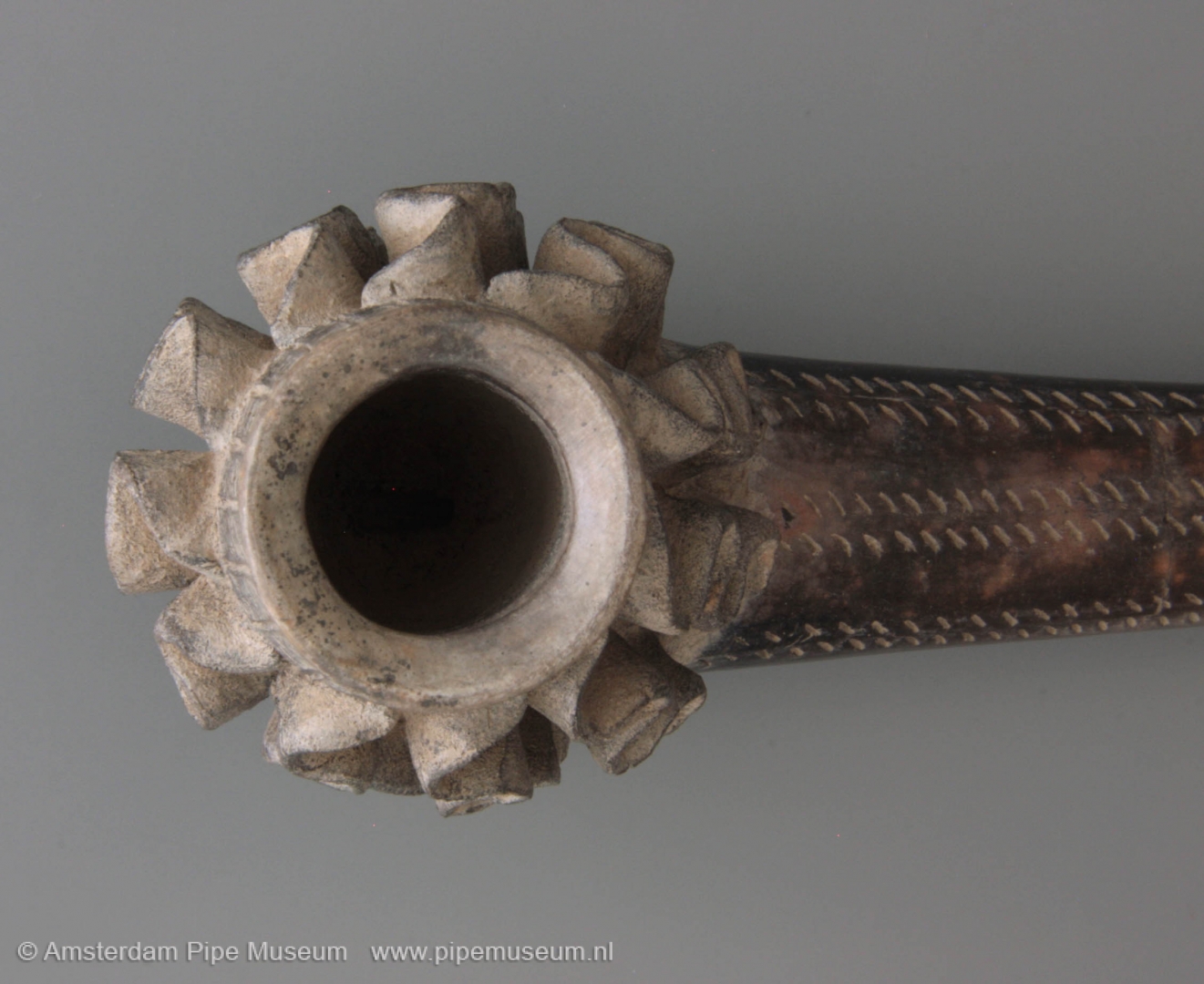
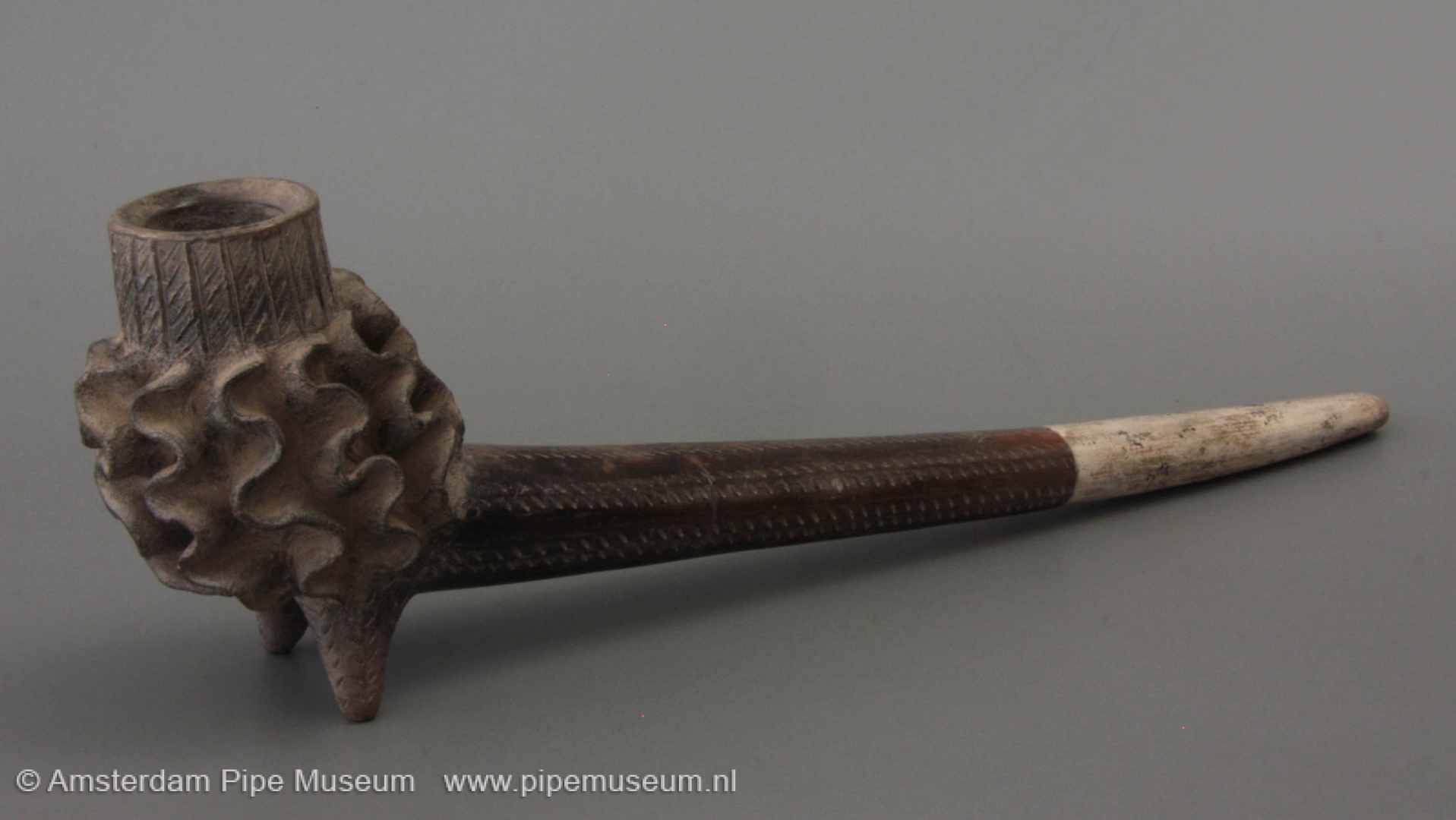
It remains an unanswerable question whether the makers of the cactus pipes have known the function of the cooling fins or have merely copied the natural shape of their beloved cactus. In any case, the ribs provide surface enlargement and thus better heat dissipation to the environment. As a result, the temperature of the burning tobacco decreases so that cooler smoke is released that tastes milder. However, the fairly massive design of most cactus pipes negates this cooling effect to a certain extend.
Literature: Don Duco, Een pijp naar de natuur, vormgevingsaspecten bij precolumbiaanse tabakspijpen (A pipe after nature, design aspects in pre-Columbian tobacco pipes ), Amsterdam, 1995.
Amsterdam Pipe Museum APM 9.622
Seated acrobat
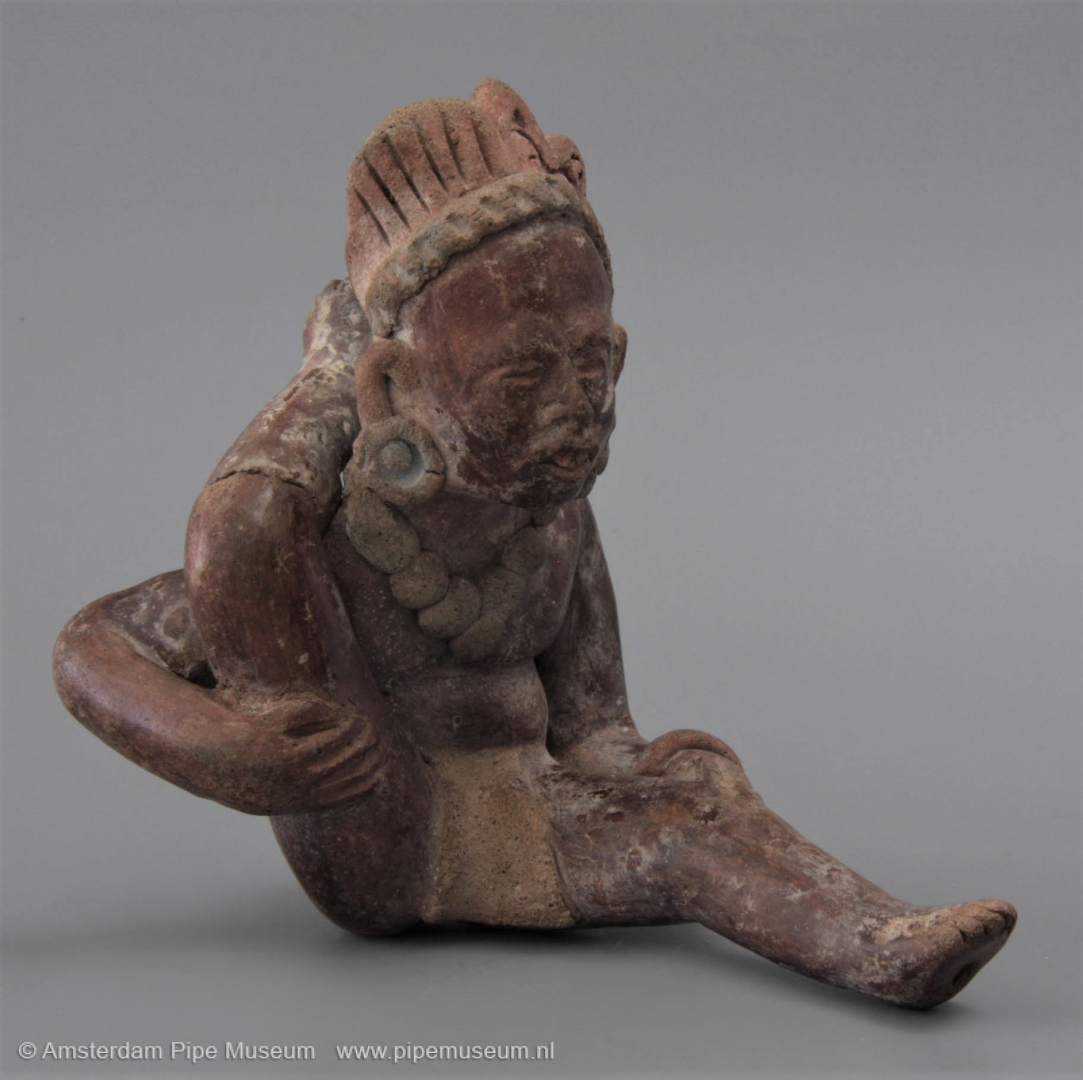
This is a very special object being a tobacco pipe from the earliest history of smoking. It is not a traditional pipe with a bowl and a stem, but an object modeled as a clay sculpture. Shown is a seated acrobat, effortlessly folding his right leg into his neck. The other leg is stretched forward and serves as the stem of the pipe. The body of the man is the pipe bowl, the beaker-shaped bowl is hidden behind the acrobat's broad shoulders. The entire object is twelve centimeters high.
The pipe is made of a gray-brown clay, which, after shaping, has been provided with many kneaded details. Eye-catching are the button-shaped earrings on either side of the face and the necklace of sturdy beads, but above all the headdress in the form of a shaped bow decorated with two different upright geometric motifs; possibly depicting a feather headdress. The crown at the top is in great contrast to the simple loincloth at the base of the pipe bowl that marks the spreading legs. Subtle detail is a refined bracelet on the left wrist of the acrobat. In its compact design with intertwined body parts, it is an extremely exciting sculpture.
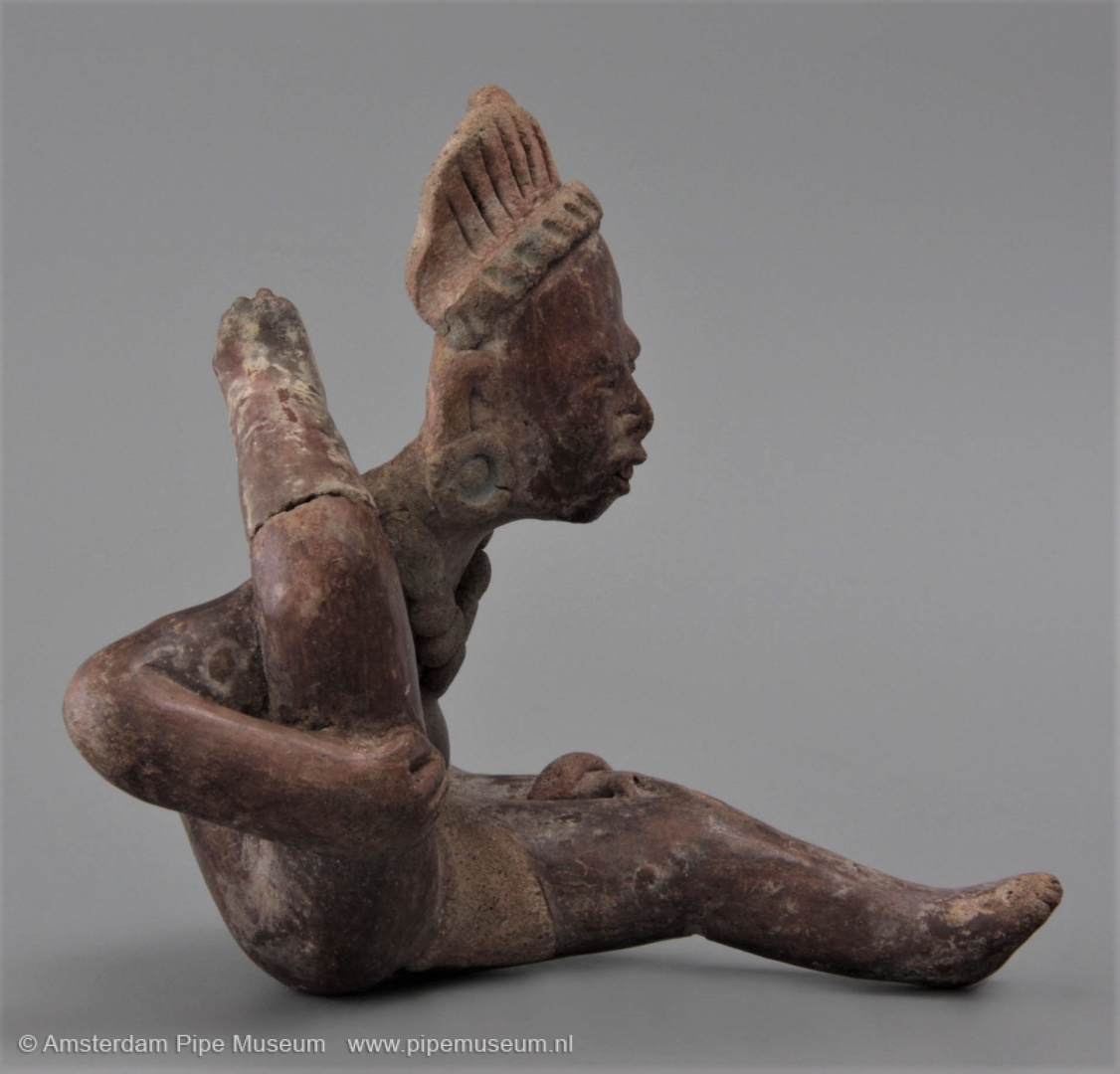
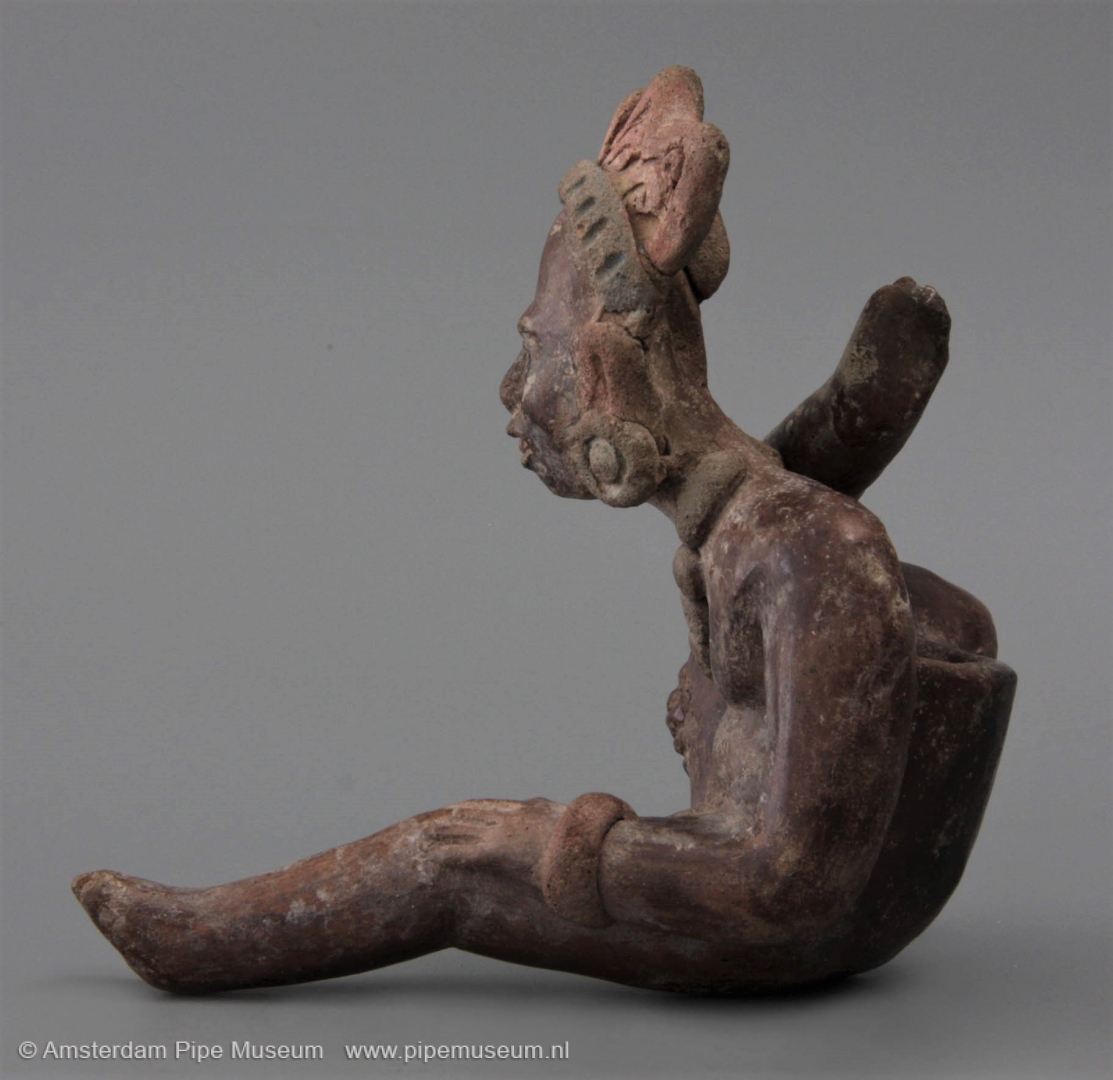
After shaping the pipe, the fresh clay is covered with a polished engobe, which provides the primary brown-red color of the object. After firing, some details have been heightened with bluish dye. Here we see the Mayan influence, characterized by painted details, mainly visible on the bow of the headdress, the earrings and the necklace. Finally, a special feature is the incissions in the teeth of the acrobat, a trademark of the culture of origin.
The tobacco pipe discussed here comes from the region of southern Veracruz on the east coast of Mexico and the object was made by the Totonac tribe. The date is somewhere in the classical period between 300 and 900 AD. This makes the piece clearly pre-Columbian. It is certainly not a pipe for daily use, the design is too complicated for that and the smoke traces are too limited. More likely, it was an object intended for a specific ceremony. Until now this is the only completely figural smoking pipe from that culture, making it a unique piece.
Amsterdam Pipe Museum APM 20.502
The primeval pipe in full
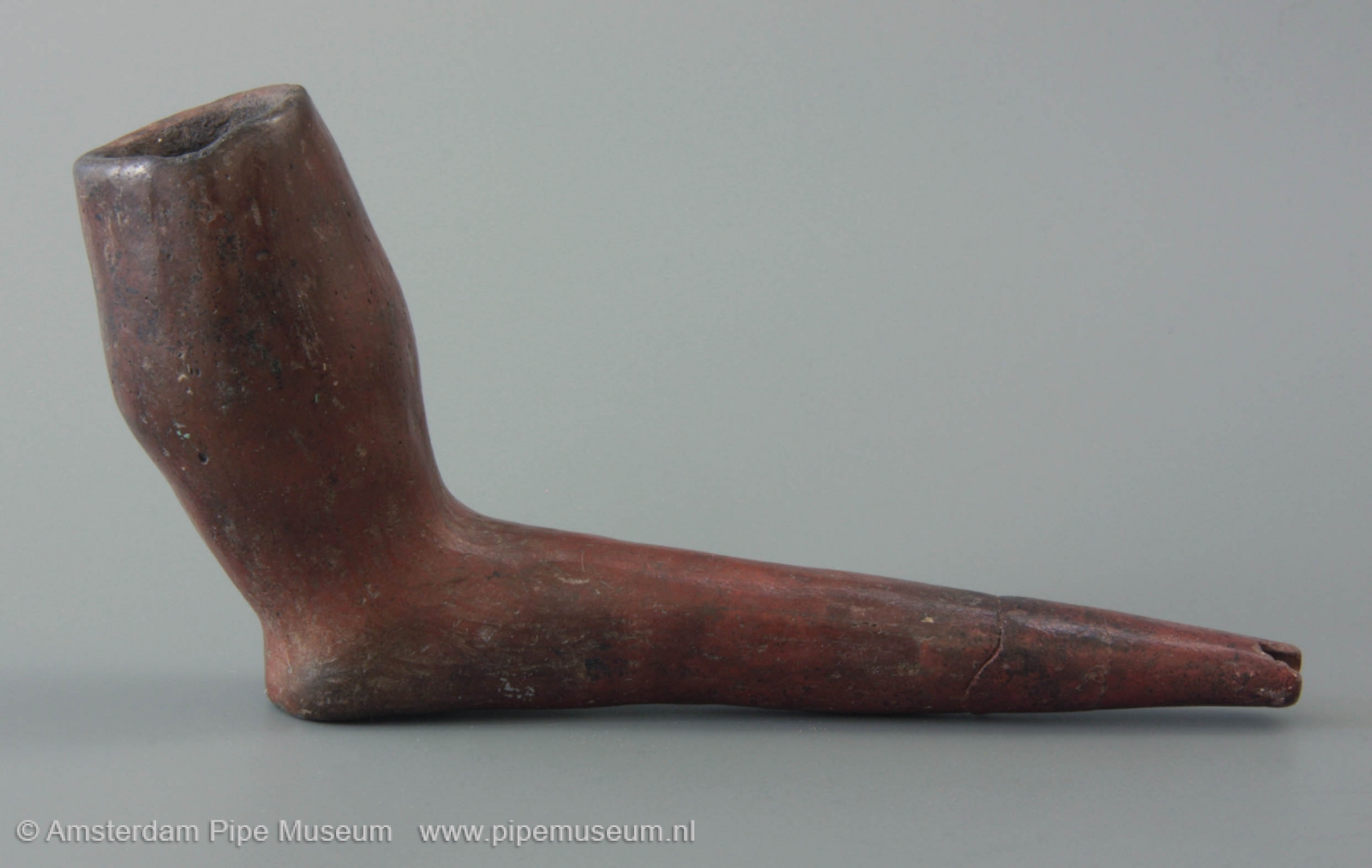
It is certain that the European clay pipe developed out of the native American tobacco pipe. Yet the number of striking similarities between pipes from both cultures is limited. Many pre-Columbian pipes have a free design in addition to a much larger size. The pipes from Central America were in fact formed by hand and could therefore have any desired appearance with a funnel-shaped or rounded bowl, either in a smooth design or with decorations.
The pre-Columbian pipe depicted here shows the greatest resemblance to the pipe shape that became popular in Europe. It is a simple pipe made of grey ceramics. After modelling the surface is covered with a red slip which has subsequently been smoothed. A more or less regular pattern of strokes is obtained by brushing along the drying clay with a hard polishing tool. After baking, this ensured a lasting shine, even after many centuries.
As expected, the dimensions of the American pipe are completely different from those of the early European counterparts. For example, the bowl has a height of almost eight centimetres and is therefore more than three times higher than that of the Dutch clay pipes from the first generation. The stem, on the other hand, is not correspondingly longer, it only measures 11.5 centimetres. Because it is thick at the beginning and tapers thinly towards the mouthpiece, the decreasing in diameter of the stem is much stronger than we see in the Dutch pipes. Despite these differences, the appearance of this American pipe with its bi conical bowl, flattened base and short, straight stem is in line with the oldest shape of the European tobacco pipe.
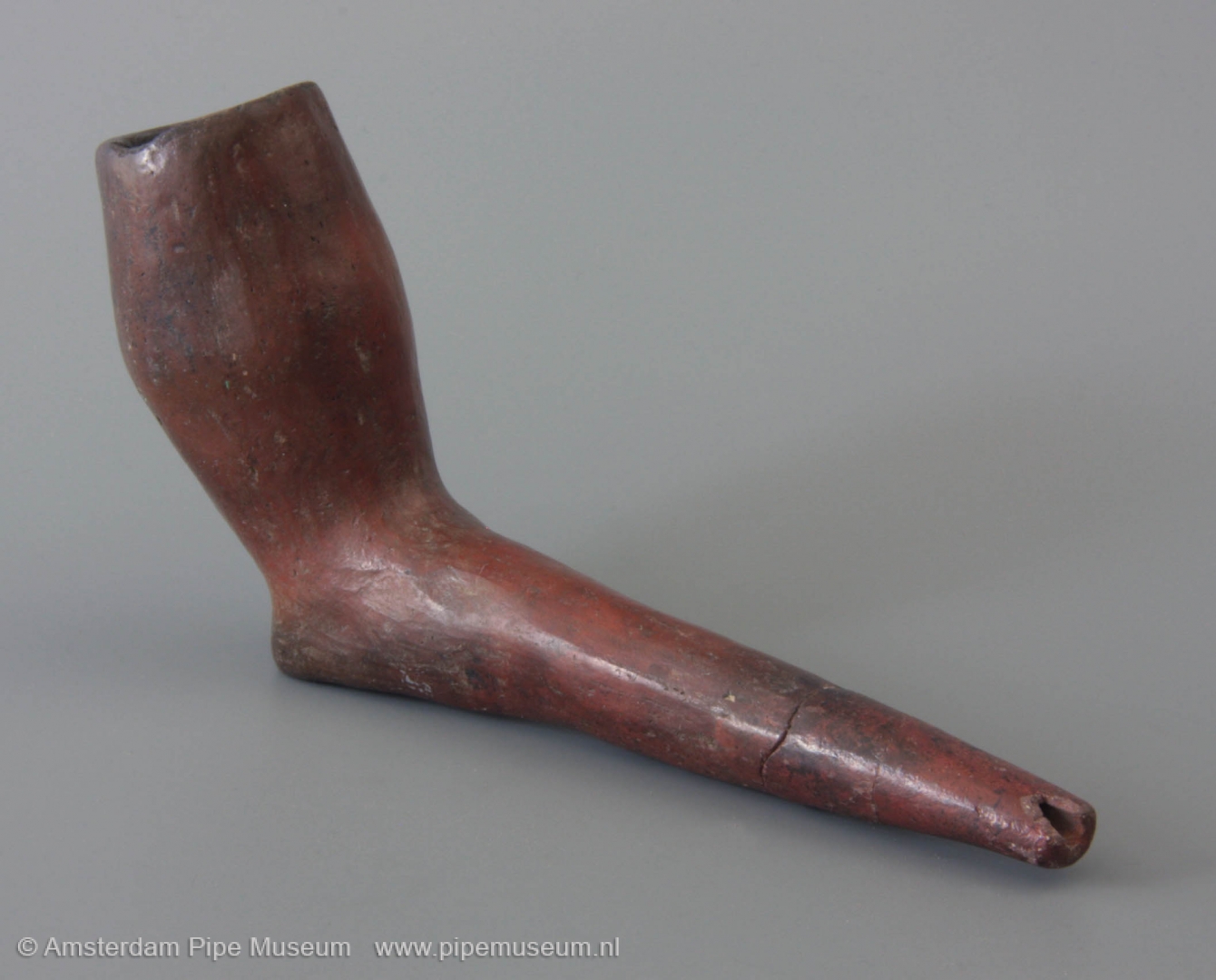
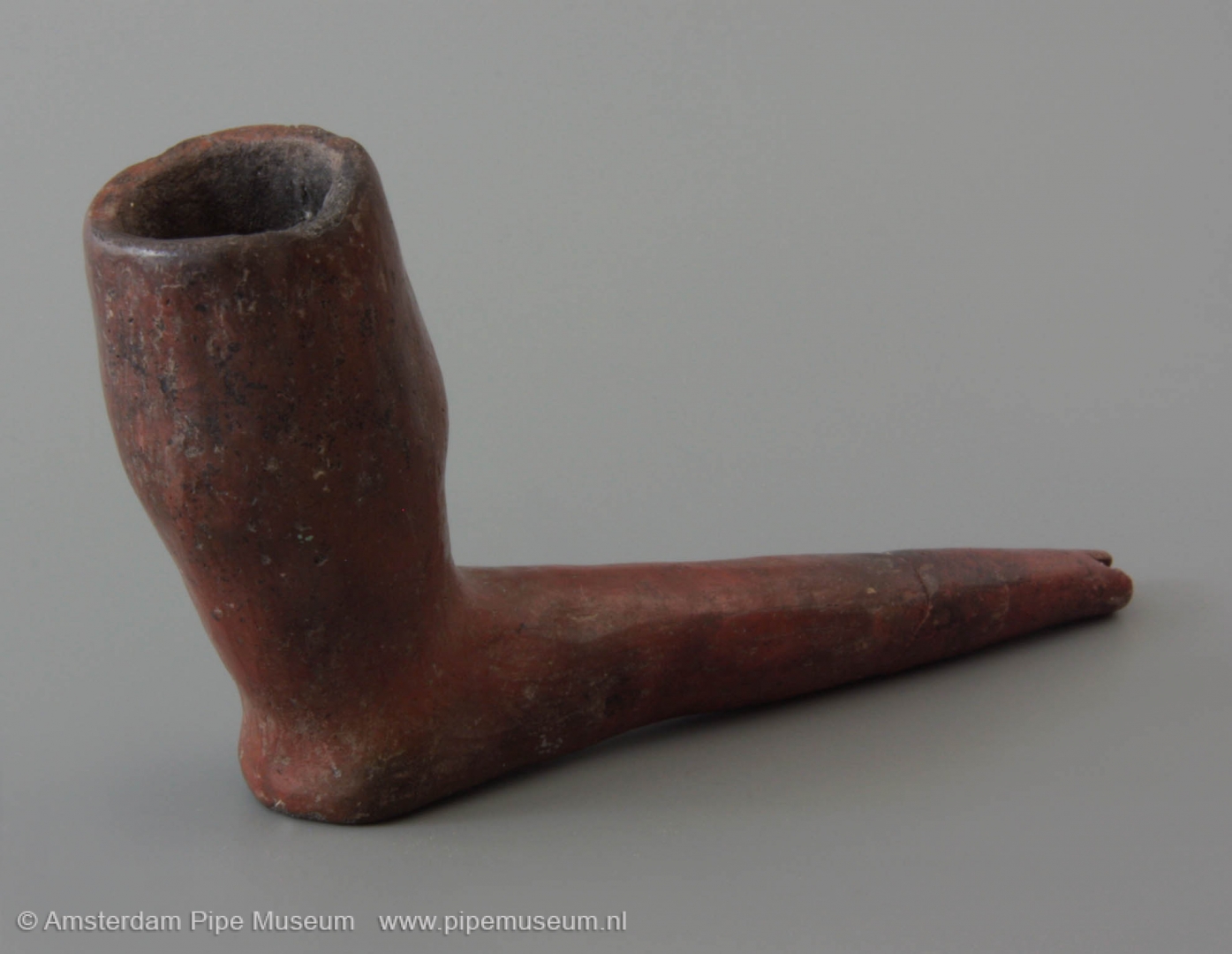
Little is known about the origin of this pipe. It must date between 500 and 1500. For decades this object was part of the well-known SEITA museum, the collection of the French tobacco monopoly. That museum acquired the pipe from the famous collection of Eugène Jance in Marseille who collected everything related to tobacco and smoking for decades. Unfortunately, insufficient attention was paid to documenting the material during the transfer of that collection. In the end Jance's notes got lost. As a result, the object information on the date, location and circumstance of the excavation, including the name of the person who found this item, was lost for posterity.
Amsterdam Pipe Museum APM 19.923